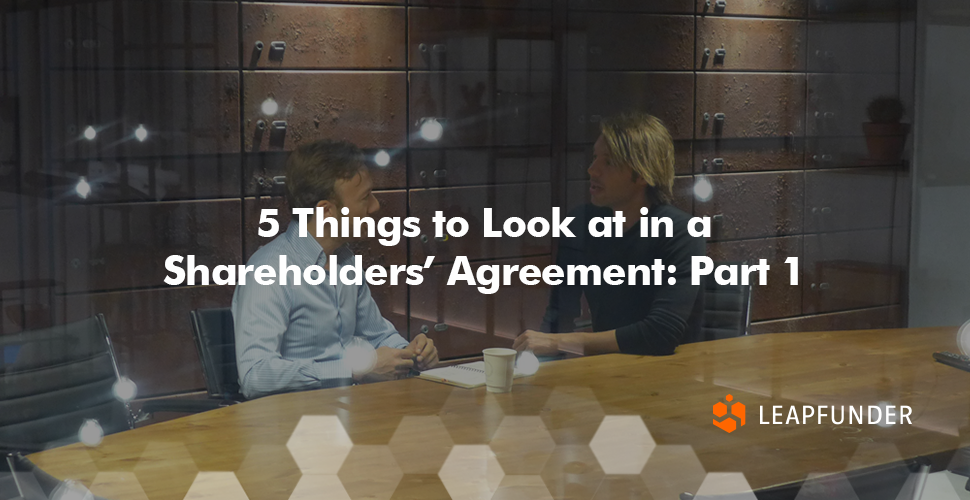
Looking at a Shareholders’ Agreement
As a startup founder, you want to work on your business. You have to find the right co-founders, employees you can work with and trust, you need funding, you need to keep your investors engaged, you need to find an office, you need to deal with your administration, and of course there are your customers which you need to service the best you can. So actually you need to be a business strategist, lawyer, developer, marketeer, customer service specialist, designer, and HR manager all at once.
For most startup founders, this is somehow manageable, but there is one topic startup founders often find it very difficult to motivate themselves to devote enough attention to. This is the shareholders’ agreement. While your shareholders’ agreement is one of the most important documents you will ever sign in your startup life.
The shareholders’ agreement is a contract between all shareholders. It defines additional agreements which lie outside of the articles of association of your legal entity. Your business very well may have been started in good faith and based on trust, but the shareholders’ agreement is there to ensure a common understanding amongst founders and later investors. The shareholders’ agreement sets the rules of the working relationship. It functions as the rules of a corporate marriage, so you can avoid potential conflict in the later stages of your startup’s life. Trust is good, a signature on a good agreement is better.
For example, in the shareholders’ agreement, you can formalize agreements between the founders about what will happen if one of them leaves the company. You can also give additional rights to some of the cash investors: this will give them the ‘preferred rights’ that differentiate their ‘preferred shares’ from the ordinary shares that the founders usually have. Preferred shares are usually granted to important financiers, which will want extra ‘rewards’ for the risks they endure by investing in a startup.
As an early-stage startup, you can choose to hire a lawyer to do the work for you. Still, it’s incredibly important to understand what the specific clauses in the agreement mean. If you don’t, you run the risk that the lawyer will decide for you what is important. Basically, you have to stay in the driver’s seat, but you can only stay in the lead if you know the rules of the road. The shareholders’ agreement is important for you, and not something which can be outsourced completely.
So I hope I’ve stressed the importance of the shareholders’ agreement. Now without further ado, below you will find 5 topics that are important to think about when you draft your SHA. Now let the fun begin!

Important topics to think about when drafting your Shareholders’ Agreement
1. Anti-dilution
When a shareholder has a so-called anti-dilution right, this means that, in some circumstances, they get extra shares. In particular, they are protected against a declining % of the shares when new shares are issued. New shares are normally created during later funding rounds. Let’s explain this with an example:
There is a startup which has 100 shares. There are 2 co-founders each having 45% of the company and 1 early investor which has 10%. The cap table – the overview of who are the shareholders of a company – looks like this:
- 45 shares co-founder 1 = 45.0%
- 45 shares co-founder 2 = 45.0%
- 10 shares investor 1 = 10.0%
At some point, a new funding round is needed. The shareholders decide that 10 extra shares will be awarded to a new investor for a certain amount of cash. So 10% more shares are issued. How would the cap table look if all shareholders have common stock? It would look like this:
- 45 shares, co-founder 1 = 40.9%
- 45 shares, co-founder 2 = 40.9%
- 10 shares investor 1 = 9.1%
- 10 shares investor 2 = 9.1%
All shareholders will dilute by the same amount: as the number of shares increases (now 110 shares) the total % of shares all shareholders drop.
So what would happen if investor 1 has preferred shares with anti-dilution rights, and the founders have common shares? Anti-dilution means that the investor with the anti-dilution rights gets some sort of compensation to prevent their % share dropping. Traditionally investors only get an anti-dilution compensation if there is a ‘down round’, so if at the next funding round a new investor comes in at a lower share price (down) compared to the previous round. The amount of compensation is agreed in the SHA.
A very strong version of this kind of anti-dilution is called a ‘full-ratchet’. It basically means that if there is a ‘down round’ the early investors will be fully compensated as if they had also invested at the lower valuation. There are milder forms of anti-dilution as well, which ensure that there is still some down-side risk for the investors left. You have to negotiate these terms when you draft your SHA.
One of the very strongest forms of anti-dilution that has emerged in recent years are the terms often used by accelerators. The accelerator anti-dilution is pretty much the strongest form of anti-dilution that’s out there. Accelerators often ask that their % share does not decline during any funding round, – whether it is ‘up’ or ‘down’ – until a certain threshold valuation is passed.
Let’s use our example again. If investor 1 and 2 were given a strong accelerator anti-dilution – and the round is at a valuation below the threshold – then it would mean that the % share will not drop, no matter what. That means that in this example, each investor gets 1.2 shares extra. The cap table will look like this:
- 45 shares, co-founder 1 = 40.0%
- 45 shares, co-founder 2 = 40.0%
- 11.2 shares, investor 1 = 10.0%
- 11.2 shares, investor 2 = 10.0%
The result is that the % for the founders has dropped additionally. The anti-dilution for investors basically means that you, as a co-founder, are losing your % in your company faster. So before you know it, you will lose a lot. Always be careful at the beginning of your startup life, because if you give away too much too soon, then, later on, you will potentially get into trouble. You can only sell a share once: good to make sure the terms are right.

We will be wrapping up Part 2 of this blog next week. Sign up for Leapfunder or keep an eye on our blog to learn more about what to include in your shareholders’ agreements – including control rights, liquidation preferences, and drag along with clauses.



